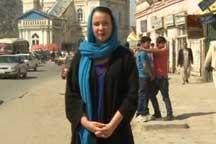Watch Video

 Play Video
Play Video
As we also mark World Heritage Day, let's go to Afghanistan to look at the country's rich history, which, despite decades of war, has not been lost. You have seen the images of poverty and war, even as recently as a few days ago. But, despite that reality, there is so much more to Afghanistan. Located along the ancient Silk Road, over time many different cultures passed through, each leaving their own little drop of influence in what has become a vast and rich cultural heritage.
With the wealth of antiquities and traditions, it is true that over 30 years of war have left much of Afghanistan's heritage damaged or destroyed completely. But since the fall of the the Taliban in late 2001, much has been done to restore what is left. We met Omarkhan Massoudi, the Director of the National Museum, who told CCTV what it was like to protect Afghanistan's history- first through the Civil War, and again during the Taliban rule.
Omarkhan Massoudi, director of The National Museum, said, "At that time, this museum was looted too much, and also unfortunately around 50, 70% of the artefacts were looted during the civil war from the museum. I have to mention for two years our relation was cut from our museum. For security we couldn't have contact with the building, with our museum."
With help from foreign donors, Mr. Massoudi and his team were able to repair the building and the artefacts that were left but damaged, due to being subjected to the elements when the museum lost it's roof, doors and windows. And then the Taliban came.
Omarkhan Massoudi said, "One thing that was a really important, this was big tragedy during the Taliban also was in 2001 they took the decision to destroy the artefacts which has human figure. simply They said that keeping a statue like this was against Islam. It was difficult to stop their action. The knowledgeable people the cultural people request them that it was part of our history we have to preserve them. But I don't know why the suddenly changed their minds and they started their action and they destroyed more than 2,500 pieces inside the museum. Among those you can see this bodhisattva."
The National Museum then took great strides, with limited resources and equipment, to repair the damaged statues, mostly buddhas thought to be from between 2- 5CE.
Massoudi said, "From 2003, more than 4,000 artefacts were restored at the national museum, also more than 300 statues that were damaged by the Taliban they were restored."
Across Kabul, in the city center, another man works to restore and preserve lost traditions in architecture. The area in the heart of the now bustling city, called Murad Khane, was in the crossfires of the civil war. Many residents simply left, and the 18th century buildings, each a previous showcase of intricate carved wood detail that is original to Afghanistan, fell into disrepair. Engineer Ahmadazai, who works with the Turquoise Mountain Foundation, tells us why his restoration work has been important.
Hedayatullah Ahmadzai, Turquoise Mountain Foundation, said, "Culturally it's good for the whole of Afghanistan's people, because if had missed it, in 2006, because the buildings were in such bad condition, if we lost it, these carvings, we lost strong culture of 250 years ago."
The rebuilding of the traditional houses, and the institute located there, is meant to both restore Afghanistan's past and teach the new generation how to continue it so that it's rich craftsmanship does not die out.
And now there is hope for one of Kabul's most iconic buildings. Once a sign of power, the Darulaman Palace, built in the 1920s by King Amanullah Khan, was ruined throughout the decades of fighting, and has become a sign of Afghanistan itself- once a majestic place, now destroyed. Finally, the city is trying to raise funds to rebuild the palace and return the building to a source of pride.
CCTV's Courtney Body said, "One main point that has been made by all of the people trying to preserve and restore Afghanistan's vast heritage, is the necessity for the younger generation to be educated and involved in their history, and to continue to move forward and rebuild their society."
Source: CCTV
No comments:
Post a Comment